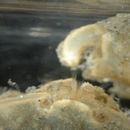Look Alikes
provided by Invertebrates of the Salish Sea
How to Distinguish from Similar Species: Mature males and females ofFabia subquadrata have long hairs on legs 3 and 4, plus the dactyls of the walking legs are strongly curved. Most other pea crabs have a carapace at least 1.5x as wide as long.
- license
- cc-by-nc-sa
- copyright
- Rosario Beach Marine Laboratory
Comprehensive Description
provided by Invertebrates of the Salish Sea
Biology/Natural History: Feeds on detritus. Also filter feeds with its maxillipeds. More than one crab may be commensal in the same burrow. The bryozoan Triticella elongata sometimes grows on the crab. In central CA, mature females are most abundant February to April but may be found from January to August.
- license
- cc-by-nc-sa
- copyright
- Rosario Beach Marine Laboratory
Habitat
provided by Invertebrates of the Salish Sea
Commensal in burrows of mudflat hosts such as Neotrypaea californiensis, Upogebia pugettensis, and the fat inkeeper worm Urechis caupo. Johnson and Snook say that the females of this species live in mussels and other bivalves.
- license
- cc-by-nc-sa
- copyright
- Rosario Beach Marine Laboratory
Distribution
provided by Invertebrates of the Salish Sea
Geographical Range: Porcher Island, British Columbia, Canada to Ensenada, Baja California, Mexico
- license
- cc-by-nc-sa
- copyright
- Rosario Beach Marine Laboratory
Habitat
provided by Invertebrates of the Salish Sea
Depth Range: Mid intertidal to 55 m
- license
- cc-by-nc-sa
- copyright
- Rosario Beach Marine Laboratory
Comprehensive Description
provided by Invertebrates of the Salish Sea
This pea crab has a hardened carapace less than 1.5x as wide as long, smooth or finely granulated. The borders of the carapace are smoothly curved. Legs 3 and 4 do not have long hairs, and the dactyls of the walking legs are not strongly curved. The males of this species have very large, thick claws for a pea crab, with a thick propodus and a short, curved, toothed dactyl. The claws of immature individuals and of females are much smaller and slender, with nearly equal fingers, small cutting teeth, and sharp tips. The cornea of the eye is red. Carapace width of females to 12.9 mm, males slightly smaller. The third walking leg is the longest.
- license
- cc-by-nc-sa
- copyright
- Rosario Beach Marine Laboratory
Scleroplax: Brief Summary
provided by wikipedia EN
Scleroplax granulata is a species of crab in the monotypic genus Scleroplax. It was first described by Mary J. Rathbun in a paper dated 1893 but only published in 1894.
Scleroplax lives as a commensal of various burrowing animals including the mud shrimp Neotrypaea californiensis, N. gigas, Upogebia pugettensis and U. macginiteorum, and the echiuran worm Urechis caupo (known as the "fat innkeeper"), and occurs from Vancouver Island, British Columbia to Punta Abreojos, Mulegé, Baja California Sur, Mexico.
- license
- cc-by-sa-3.0
- copyright
- Wikipedia authors and editors

